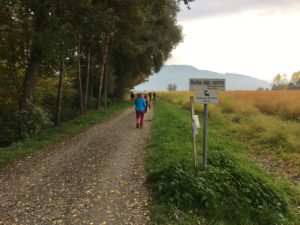
On a rainy October day the border between Austria and Switzerland, more precisely between Lustenau and Diepoldsau, became a hub of curious folks from both sides of the Old Rhine. The association for the protection of nature (at least that’s my guess how to translate the „Naturschutzgruppe“) from Diepoldsau in Switzerland – next to Hohenems – presents a very special kind of outdoor exhibition along the Old and New Rhine. Our friends from Frankfurt are here for the weekend. In the summer we walked along the river Main with them, from the European Central Bank to the new pubs on the banks, where Frankfurt is posh and enjoying itself. The European Central Bank might be the true heart of Europe, but the innocent banks of the river Rhine might be the stomach. So we offered our friends a tour.
Three little cabins, or shelters so to say, that once helped border police to find refuge from rain and snow, are now neatly painted in red, green and yellow – and filled with installations about three subjects that informed the life of this region for many years: smuggle, refugees, and border control. Three perspectives on the same liminal space: the one of the locals, many of them having a story of smugglers in their own family. The one of those who try to find refuge from something more serious than bad weather. And the one of the state, and the young man engaged in what was considered the essence of Swiss sovereignty: the control of its borders.
Thousand of Jewish refugees were seeking a way to freedom here in 1938, some crossed the river where it was shallow. Some sneaked over the bridge in the night. There were many ways here, and nobody knew for sure which one was working, when, and at what time. Some of these refugees had their roots in Hohenems, like Alfred Munk and his sister Gertrud from Vienna, who crossed the border here already in April 1938. But the number of stories one could tell is endless. We’ll work on it, one by one by one.
The little exhibitions inside of the huts are simple and thoughtful, not partisan but emphatic, giving all these conflicting perspective their voice. And leave it to the eye of the beholder to draw conclusions. Who knows wether we are confronting only the past, or some future?
Margit Bartl-Frank, the artist and friend of the museum, living on the Swiss side of the Rhine, made the story of the Jewish refugees already several times a subject of her installations. This time she confronted the account of the Kreutner family, who succeeded to enter Switzerland in the fall of 1938 through Hohenems with the story of the Abdolzaher family from Herat in Afghanistan. Their odyssey lead them by foot through Iran and Turkey, on a boat to Greece, through Macedonia and Italy to France, and finally to Diepoldsau in Switzerland, where they now learn German and seek a job. Faride and her little daughter Setayesh answer questions patiently and stood beside the old border post in the rain. What will be their future? Nobody knows. But many got an idea: it will not only depend on them, but also on us.
Our friends are a bit ahead of us. In Frankfurt they have two kids from Afghanistan at home, giving them shelter and a bit of support for their possible start into a new life. Not easy at all. The boys have to start from scratch, they hardly visited school in their life before. Working on construction sites in Pakistan was their education. Faride might be better off, she was a nurse in a hospital, her daughter already speaks German with a heavy Swiss accent. A little later we see her on her little bike, riding joyfully between the yellow and the green cabin. She seems to be at home in Diepoldsau. Unbelievable.
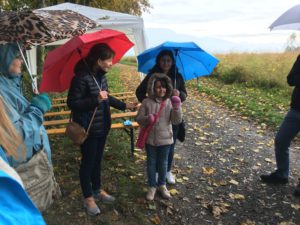

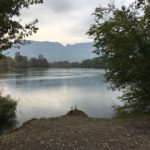
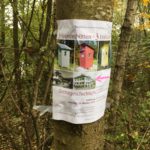
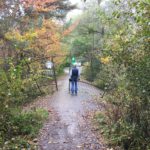
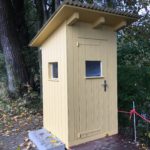
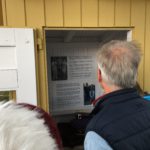
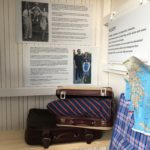
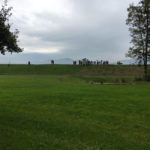
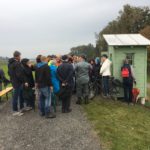
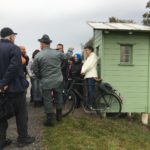
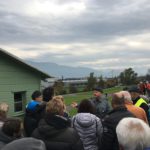
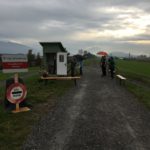
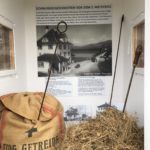
Dear Hanno,
Your sensitive story about the Afghan family, coupled with the xenophobia presently raging among so many Trumpists nowdays , inspired me to write you about so many remarkable similarities between the museum and our family history. Previous blogs on the food festival, on Merano, Jessica Piper’s beautiful reports and other occurrences have made me think of the many miraculous coincidences that we share with you.
Let me explain: I was born in 1925 in Vienna and lived in Siebenhirten, a small southern suburb, where my father Bernard Billes was Gemeinde-Arzt until the Nazis kicked us out shortly after the Anschluss in 1938. Through good fortune and a wonderful uncle in Detroit, Michigan we were able to escape to the USA in 1939; our entire family in the Lemberg region was massacred. Through education and hard work we got on our feet again. I married my lovely wife Doris in 1952, and we began to take annual summer vacations in central Europe, always by rental car. We avoided Germany and Austria at first, travelling in France , Italy and Switzerland. Gradually my aversion to visiting Austria weakened, especially when a small Gasse in Vienna was named in memory 0f my father. We wanted to take care of my grandparents’ graves in the Vienna Zentral-Friedhof and see some Christian friends who were so good to us during the Hitler time. So in about 1985 we began our annual visits to Austria , touring and hiking and enjoying the cultural offerings. The last 25 years we stayed mainly in the Gastein Valley south of Salzburg. Since we used Munich as our airport we went several times to operas at the nearby summer Bregenz Seebuehne. In about 1995 we visited the Bregenz tourism office, and saw there prominently displayed a row of brochures with the yellow Jewish star–of your museum. Naturally we visited the Museum and cemetery and fell in love with it. We have been there several times, seeing the exhibit about Jewish love of the Alps, the ” Street Car Named Desire”last year, and several others, witnessing the creation of your Salomon Sulzer Saal, and the great improvements you have made. Unfortunately during our visits you were not there. We are also happy supporters of the American Friends and through Susan Shimer’s informative news letters we have become pseudo-cousins.
Now to some of the coincidences which bind us. In the fall of 1938 my father was to have crossed into Switzerland via Lustenau. The money was paid, his suit case was packed , but at the last second something went wrong and he was not taken. He was indeed lucky, because that trip was intercepted and foiled. I do not know what became of the participants.
On several occasions we spent vacations in Merano, driving there through the beautiful Oetztal. While there we visited the synagogue and the museum in the basement, with the prominent display of thr Taenzer name and other Hohenems dignitaries. There was a sudden loud explosion that shook the building. Fearing a bombing we rushed out of the building, but there was no evidence of a bomb–the eruptoin was caused by an earth quake centered in nearby Bolzano. There was considerable damage in the area, particularly by the river, but we finished our stay at the Hotel Irma without further difficulty.
My last Geschichte concerns your food festival. It has to do with Joseph Wechsberg, a Moravian -born author who wrote brilliantly on subjects as diverse as music and opera, on FOOD (So Kocht Man In Wien”),and on sophisticated travel. In the 1950s and ’60s I read many admirable articles of his in the New York Times, in Gourmet magazine and in the New Yorker. Then he disappeared from print. On one of our trips to Merano in the early 1990s we visited the Jewish cemetery there, located in a row of other cemeteries. An there ,to our astonishment, on a grave next to the wall was a simple pyramidal stone marked only “Joseph Wechsberg”, I was able to establish through the NYTimes that Wechsberg had lived in Vienna and died there in 1983. I have never been able to find the cause of his death nor why he was buried in Merano, a town so related to Hohenems. If someone could enlighten me at edbill@gmail.com I would be grateful.
So ends our saga about our relationship to Hohenems. By the way, we have a great Holocaust Memorial in Farmington Hills, Michigan, of which we are very proud and to which Doris and I have contributed. If you are ever in our area we would be very happy to accomodate you
Shalom,
Eric and Doris Billes